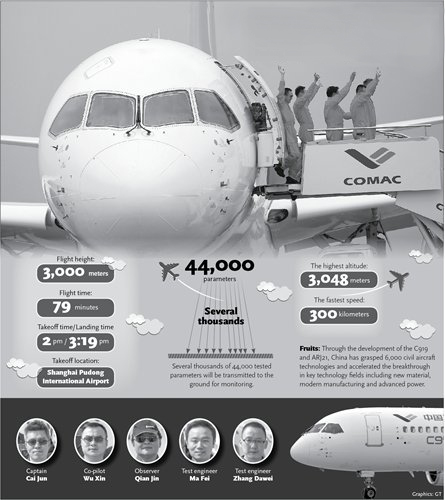
Spectators take pictures of the C919 which took off at 2 pm from the Shanghai Pudong International Airport. The aircraft with five crew members on board landed at 3:19 pm after a successful maiden flight. Photo: CFP

C919's test flight captain Cai Jun, co-pilot Wu Xin, flight observer Qian Jin and two test flight engineers - Zhang Dawei and Ma Fei - wave their hands after the aircraft landed at the Shanghai Pudong International Airport. Photo: CFP
After a flight of 79 minutes, the homemade C919 jet landed at the Shanghai Pudong International Airport on Friday, completing its maiden flight successfully.
The aircraft took off at 2 pm and landed at 3:19 pm, with most of the time spent in the sky over Nantong, East China's Jiangsu Province, 128 kilometers away from Shanghai.
The twin-engine plane departed with five crew members on board but no passengers. The flight was greeted with applause by more than 1,000 spectators on the tarmac, including Vice Premier Ma Kai and Shanghai Party chief Han Zheng.
The State Council, China's cabinet, sent congratulations in a statement on Friday, hoping that the aerospace staff will stay true to the mission and endeavor to build large aircraft as a typical engineering project for a manufacturing power.
More than 3,000 guests attended the ceremony at the airport, and cheered the aircraft at both its departure and return.
"The success of the maiden flight is within my expectation, and the aircraft will definitely be successful after the full preparation," Lu Feng, an expert on national industrial policy research from Peking University, told the Global Times after watching the takeoff.
It is a milestone in the Chinese aviation industry and shows that China has developed the core technology to build a modern airplane, manufacturer of C919 Commercial Aircraft Corporation of China Ltd (COMAC), said on Friday.
The C919 program is part of China's ambitious move to elevate the status of aviation industry, with the aircraft widely believed to be the answer to the A320neo and Boeing 737 MAX, the updated versions of the narrow-body aircraft which have been most popular in the Chinese market for many years.
"This is a great achievement in the history of COMAC and an important milestone for Chinese aviation," Kevin McAllister, president & CEO of Boeing Commercial Airplanes, said in a note sent to the Global Times on Friday.
Airbus said in a statement sent to the Global Times on Thursday that "we believe C919 will bring new competition to the market. And we welcome competition, which is good for the development of the industry."
The New York Times published an article on Friday, saying that the C919 is years - if not decades - behind aircraft made by Airbus and Boeing that are cheaper to fly and easier to maintain, but "for a country that only 40 years ago was one of the poorest in the world, the C919 symbolized the industrial might of an emerging superpower - and its dream to dominate a new technological era."
However, the C919 is not yet cleared for commercial operations, though its maiden flight is an important step on the road to gain certification from the regulators.
COMAC said that more than 220 companies with more than 200,000 people in China are involved with the C919 project, covering the processes of design, assembly, services, supplier management and marketing.
Companies under Aviation Industry Corporation of China have contributed the major part of the main manufacturing, including the cockpit, the body and the central wing.
Also, 16 joint venture suppliers, including GE, Honeywell and CFM, are involved in the avionics, flight control, power, fuel and landing gear systems.
Zhou Guirong, deputy chief designer of the C919, said at a group meeting with media on Thursday that the overall localization rate of C919 aircraft can reach over 50 percent, which means more than half of the components are from the domestic enterprises and the joint ventures between domestic and foreign companies.
"The design concept of the C919 is the same as the planes from Boeing and Airbus as they aim to procure the world's most advanced parts, and the C919 took the advanced technologies," Xiang Weiming, president of GE Aviation Greater China, told the Global Times on Friday.
Nate Boelkins, vice president of Electric Power Systems, UTC Aerospace Systems, said that its technology can be found throughout the C919's key systems including electric power, emergency power and cockpit.
"We have built a strong working relationship with COMAC," added Boelkins. "And we look forward to celebrating many more milestones with COMAC in the future."
"The C919 is a sleek, modern and efficient airplane. It is ready to compete on a global scale, heralding China's ambitious plans to grow and develop its domestic air transportation industry," Steven Lien, president of Honeywell Aerospace Asia Pacific, said in a note sent to the Global Times on Wednesday.
Before the takeoff, Zhou told the Global Times that while developing key technologies, the C919 is also dedicated to the localization of production by the domestic enterprises and joint venture enterprises. However, it also faced challenges. For example, as the US banned its institutes from providing "control law," a key technology, the designers had to develop the technology by themselves. Luckily, they finally mastered the technology.
Fierce market competition
Insiders say upgrading C919 technology to keep up with its competitors is a concern, as rivals continue to optimize their systems in a move to keep their dominance over the market.
"Even after gaining certification, the C919 will still face the challenge of how to make itself more competitive in the market, and this is quite complicated," Wang Ya'nan, editor-in-chief of the Aerospace Knowledge magazine, told the Global Times on Friday.
According to Wang, this will include improving airplane safety, reliability and efficiency, and the C919 faces a daunting test in keeping up with the technological upgrades consistently carried out by Airbus and Boeing in these areas.
The current priority is to earn its commercial business certification as early as possible, Qin Ling, a market watcher, told the Global Times on Friday, noting that the C919 can learn precious experience from its rivals.
However, he noted that it could not command the market share of the A320neo and Boeing 737 MAX in the short term, as it will still take a long time to turn these plans into reality.
"The medium-term target is to win more orders from domestic carriers and to turn the C919 into a series," Qin said.

